The old standard for contracts is on its way out, shaped by industry changes in information design and user experience. The new standard encourages contracts that are visually pleasing, easy to understand, and build an open and friendly relationship between consumers and companies. Attorney Olga Mack, CEO of a next-generation contract management company, shows us how Google and Apple are using innovative design techniques to produce eye-catching, straightforward and user-friendly contracts and how other companies are sure to follow.
Questions in this Episode:
- Why are contract drafting attorneys using information design?
- How is negative space effective?
- When should a contract be like a conversation?
- What are contract guideposts?
- How does contract design help with compliance?
The Current Changes in Contract Design
Contract design is changing how businesses present contracts and other legal documents to their clients and consumers. Today’s contract design is not about changing font sizes or margins. Visual elements, simplified text, short header sections, brand elements and colors, and white space help guide the users’ eyes quickly to find the information they want.
This episode reviews two documents that use design and layout to give users a better experience and allow the companies to be more consumer-friendly and transparent.
The first is Apple’s App Privacy Details on the App Store, which Apple recently rolled out. To help consumers understand what data an app might collect from you after purchasing it, Apple created what is commonly called Apple’s Privacy Nutrition Labels.
With 2.2 million apps available through the Apple App Store, this is a significant move toward informing consumers about data collection practices.
The label categories are data used to track you, data linked to you, and data not linked to you. As of December 2021, Apple requires all apps found on the Apple App Store to disclose their data collection practices.
To explain this new policy to consumers, Apple has visually and creatively designed its Privacy Policy Details document to help users easily and quickly find any specific information they need.
Google’s business model is different and revolves around collecting, sharing, and selling consumer and business data. But Google, like Apple, is using current contract design techniques to communicate with its users.
Google’s new Terms of Service Agreement is an evolution in terms of its substance and presentation. The text is simple and the attractive document has plenty of white space and illustrations to guide your eye through the information.
While the substance of the two documents is different, they both illustrate the future of contract design.
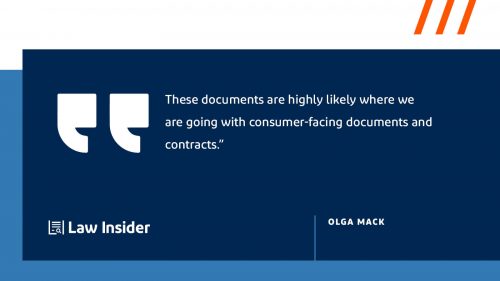
Information Design is Changing Contracts Into an Experience
The first thing you notice about the Google and Apple documents is how different they look from other contracts you review. These do not look like the contracts you got used to seeing in your law-school contracts case books.
The evolving field of information design is changing the world of contracts.
All legal assets and contract assets are becoming an experience for the user.. Documents are not just useful but a place of delight and engagement, where you can find things easily and without fear. Doing that requires an experience, and all experiences are possible because they are designed.
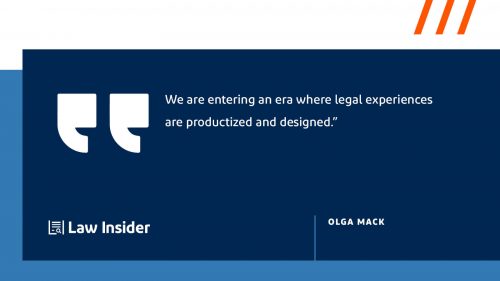
Contracts can now present information in a way that is useful and of service, giving the user what they need when they need it.
Various design principles have been evolving, and Apple and Google are now incorporating these principles in consumer-facing documents. Although information design has been evolving for years, we are at the beginning of a significant change in the legal community. Lawyers don’t have to know the complete science of information design, but should be aware enough to ask the right questions to help create these documents for their clients.
Lawyers are increasingly working with information designers, just like they worked with technologists and financial professionals.
The Positive Effects of Negative Space
Google is famous for having clean open designs. While companies like Yahoo had crowded and confusing landing pages, from the beginning Google’s site was a white page with a single block in the middle. Today, Google’s new Terms of Service welcomes you with an abundance of white space. In design, this is called negative space.
Negative space is the area around the elements that is left empty. You cannot have an image without the contrasting negative space around it. One way to make important written information stand out is by using the visually contrasting color of the negative space.
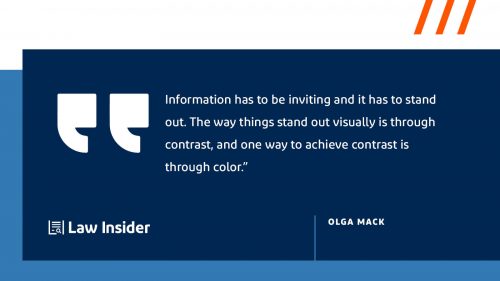
Apple and Google use an increasing amount of white space to guide the viewers’ eyes to what is essential. This contrast invites your eyes to be part of the conversation and leads you to crucial areas of the document.
As you scroll down Apple’s document, it is apparent that Apple is guiding your eyes to various heading, tables, and elements by leaving chunks of white space.
And if you want non-lawyers to read your document, you have to make it readable, and contrasting colors can help. And you are not stuck with black and white. Red and green, blue and yellow, and other opposing color pairs work.
Businesses spend fortunes on SEO and advertising to get you to their websites. But once there, you are often met with a confusing wall of text. It is not inviting or enjoyable, and it is not on brand.
Google and Apple share similar branding elements like minimalism, simplicity, clean elements, and not too many colors. They incorporate these branding elements in their documents and guide their viewers’ eyes as they experience the page.
The Contract as a Friendly Conversation
While these documents are legal contracts, they read more like helpful blog posts and feel like conversations with friends. You notice a lack of legalese or legal voodoo in the simple language used.
For example, companies know that consumers rarely read the terms of service. But Google starts their document with a large message to get your attention and then talks to you like a friend saying, “We know it’s tempting to skip these Terms of Service, but it’s important to establish what you can expect from us as you use Google services, and what we expect from you.”
These are still legal documents covering legal issues, but they are void of archaic and stuffy legal terms like “Heretofore,” “party of the first part,” “Whereas,” and more. This seems more like a conversation, and the user is addressed as “You.”
Google is saying, “thank you for stopping by,” “we are here to serve you,” “here is something important we think you should read,” and more. The user feels as if the Google is their helpful and informative friend.
Visual Elements Make Browsing Fast and Enjoyable
Apple and Google clearly designed these documents for browsing. They are functional documents you use to get information. These are not novels you read from beginning to end, suffering through some parts and enjoying others. That is not the experience.
For example, when you come to Google’s Terms of Service, you are looking for certain information. You might want an email address to contact someone or have a specific question. Google understands you will be browsing. And they help you with large font size, short, and descriptive headings, often just one or two words like “Privacy Link” or “Tracking.”
A sidebar follows as you browse and allows you to instantly jump between sections without tedious scrolling. You can zero in, get the information you need, and leave. To help you browse, within the sections there are lots of short bullet points, some not even complete sentences.
Google uses these simple visual elements as guideposts and incorporates Google’s branded color scheme. The visual guideposts are functional and tell you things like “you are about to read a section about your relationship with Google and your other devices.”
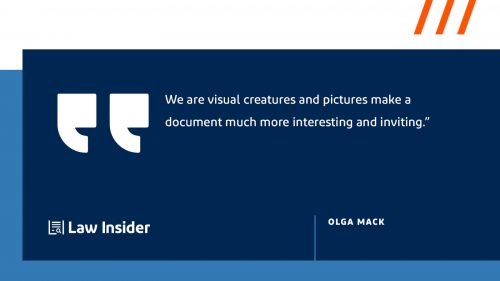
The Google visuals are an extension of the Google brand and are functional as guideposts but don’t relay substantive information.
Visuals have three functions – branding, guideposts, and functional drawings that include information in a visual format like tables.
Apple uses functional drawing in their document by using a table to give you information. But this is not an Excel-like table. This is a visually pleasing table that used icons to guide you. The heart icon guides you to the Health and Fitness information, the credit card logo guide you to the Financial Information, the eyeball logo leads Sensitive Information data section, and more.
And Apple uses proximity to organize the data for you, like putting all the house information under one subheading, and all the financial information under that subheading.
This is a very multi-layered experience that visually stands out because of the white space around it.
And if you are looking at “location”‘ information and want to go the the “tracking” section, you just click on the sidebar and are instantly taken there.
With these documents, you are now getting the experience of quickly seeing, easily navigating, instantly jumping from section to section, being guided to your wanted information, getting quickly served, and getting out.
The Lawyer’s Changing Role
The lawyer’s role in business is changing. No longer are they just supporting the business. Often they are driving the business. Certainly, the legal experience is now part of the business.
And many products created today are legal products. At a minimum, all businesses will have terms of service, privacy policies, and more, and these legal documents are part of the product.
You, as a drafting attorney, are not creating some academic work. You are creating part of a product.
And business competition is fierce. Consumers have many choices of products and services.
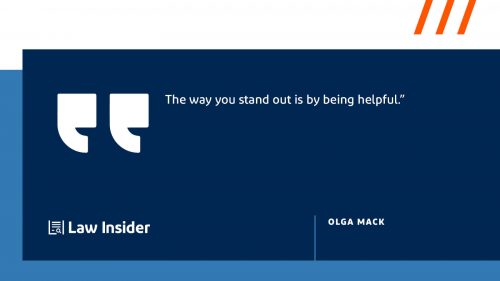
Everyone’s helpful when consumers are buying the product.But what about when they have a bad experience, when they are frustrated, when they have questions, or when they are in the darkest moment.
People look at terms of service agreements when they have problems or questions. That is the time to be helpful.
There is a realization that lawyers do much more than being the shield and the sword to protect the business and slay the enemies.
Today, as part of the business, lawyers are helpful and drive business. And legal documents are part of the experience.
The Future of Contract Design
Contracts are always under the eye of ever-changing laws and legislation. For example, the GDRP is a very complicated piece of consumer-protecting legislation that has been evolving over the years.
But the GDPR is also viewed as enlightened legislation that is trying to keep the protective laws up with the rapidly changing technology.
Currently, Article 5(1) of the GDPR states that “Personal data shall be processed lawfully, fairly and in a transparent manner in relation to the data subject…”
While the legal terms of “lawfully” and “fairly” are well established, what does “transparent” mean today?
Ten years ago, just putting a bunch of legalese was transparent. But our societal expectations of transparency have evolved. - Olga Mack #ContractTeardown Click To Tweet
Today you cannot just bury terms in plain sight under pages of hard-to-read text and claim transparency. The principle that documents must be more consumer-friendly is becoming increasingly codified.
Contract drafting attorneys, working with information designers, have the tools to make consumer-friendly and aesthetically pleasing documents that are easy to navigate and extremely transparent.
The visual look and functionality of contracts are rapidly changing. Not only does this help with compliance of more consumer protective legislation, but it is good for business.
As you create your contracts you are designing the consumer’s experience with your company. With the aid of information designers, you can deliver an easy-to-use, functional, and visually pleasing contract that helps the consumer and also drives business. There is little question that this is the future of contract design. The only question is how you will use it in your practice.
SHOW NOTES
In this episode of Contract Teardown, Olga V. Mack, CEO of Parley Pro and contract law extraordinaire takes us through emerging trends in consumer contracts spearheaded by big tech companies like Apple and Google. Watch as she tears down Apple’s privacy details and Google’s terms of service, highlighting how design innovations are shaping consumer-friendly documents that are simple, easy to use and esthetically friendly.
THE GUEST: Olga V. Mack is a strategist, nationally recognized author, public speaker, and women’s advocate. She serves as the CEO of Parley Pro, a next-generation contract management company that has pioneered digital negotiation technology. She has also served as Vice President of Strategy at Quantstamp, the first decentralized security auditing blockchain platform, and General Counsel at ClearSlide, a sales engagement platform. She also has held various roles at Visa, Zoosk, Pacific Art League, Wilson Sonsini, and Yahoo.
Olga embraces legal innovation and has dedicated her career to improving and shaping the future of law. She is convinced that the legal profession will emerge even stronger, more resilient, and more inclusive than before by embracing technology. She shares her views in her columns on Above the Law, Bloomberg Law, Association of Corporate Counsel (ACC) Docket, Newsweek, and Venture Beat. Olga also recently presented on How Smart Contracts Will Change the World at TEDxSanFrancisco. In addition, she authored Get on Board: Earning Your Ticket to a Corporate Board Seat, Fundamentals of Smart Contract Security and Blockchain Value: Transforming Business Models, Society, and Communities.
Olga is also very involved in her community. She serves on numerous boards and advisory boards. She founded the Women Serve on Boards movement that advocates for women to serve on corporate boards of Fortune 500 companies. Olga also co-founded SunLaw, an organization dedicated to preparing women in-house attorneys to become general counsels and legal leaders, and WISE to help female law firm partners become rainmakers. She lectures at Berkeley Law and has received numerous awards for her work, including the Silicon Valley Women of Influence, Make Your Mark, Corporate Counsel of the Year, and Women Leaders in Technology Law.
THE HOST: Mike Whelan is the author of Lawyer Forward: Finding Your Place in the Future of Law and host of the Lawyer Forward community. Learn more about his work for attorneys at www.lawyerforward.com.
If you are interested in being a guest on Contract Teardown, please email us at community@lawinsider.com.
Interview Transcript
Mike Whelan [00:03:56] Hey, everybody! Welcome back to the Contract Teardown show from Law Insider, I’m Mike Whelan. The purpose of the show is exactly what it sounds like. We take contracts, documents, we beat them up. We’re mean–occasionally nice. I bring on smart friends like Olga Mack here. Olga, how are you today?
Olga Mack [00:04:12] Mike, I am great. It’s good to be here.
Mike Whelan [00:04:16] Good. I’m glad to have you. I will warn everybody I’ve got the man flu today. The man flu is like the regular flu, except whinier, because that’s what–men will complain more. So if you hear like I’ve got a muppet voice man flu thing, that’s why. It’s not Olga’s fault, it’s not the recording device, it’s the talent. So guys, today what we’re doing is going through a couple of special documents because we’re getting into kinda the nerdy. We’re stepping back a little bit on the purpose of these documents and how design and layout can impact them. So we’re going to talk about these two documents, one from Apple, one from Google. Olga Real quick. Tell me what these documents are. Why are we looking at them? When are we as lawyers going to run into these kinds of documents?
Olga Mack [00:04:57] Yeah, those documents [muffled]. We’re talking about Apple’s app privacy details, which is the program that was recently rolled out. Apple designed what’s called privacy nutrition labels, as they’re kind of more widely known to help users to better understand an app’s data usage practices before they download. And so they’re essentially encouraging developers for each–for every app, which is we’re talking about 1.8 million apps on the App Store to follow strict privacy guidelines and report how that data is collected. And so they made an effort to provide guidance. And recently, Google came up with a different, slightly different document with just terms of services, which is an evolution in terms of services for Google, both in substance and presentation. And those documents are highly likely where we are going with consumer-facing documents and contracts.
Mike Whelan [00:06:02] OK, cool, so here are those two documents and what’s neat about these in this context, if you guys have not paid attention to this, Apple–and this is consistent with their business model, so it’s nice to act like they’re holy and righteous here–but Apple has been really deliberate and diligent about privacy of late. You’ve seen ads for this. Google famously is not as concerned about it. You know their whole business model is built on using your data in different ways and sharing it in different ways and selling it in ways that really drive their model. So it’s an interesting contrast in these two documents. And what we’re going to do is look at these in an original way. And part of that is because of your background, Olga. Tell us real quick about your background. What brings you to documents like this? What gives you this unique perspective that you have?
Olga Mack [00:07:05] So today I’m building the future of law, specifically the future of contracts. I’m CEO of Parley Pro; I joined about two years ago. I helped to refine the product and onboard all the customers we have. It’s basically a CLM, or a contract lifecycle management platform, we do exactly what you would expect a CLM to do. We cover every stage from request to generation to negotiation to signature to post signature. We are very data-driven, easy to use and give sort of real, real time collaboration. We have pioneered digital negotiation technology and in the end, what we strive to do is to serve the entire organization and give you a relationship with a contract. And I truly think that we all have a relationship with the contract that is dysfunctional, that is appropriate one, to your function and two, to the stage of a contract. And today, most of us, from lawyers to business professionals to consumers have a highly dysfunctional relationship. We don’t know what’s in it. We don’t know how to engage. And we’re most certainly underserved by the contracts we have.
Mike Whelan [00:08:19] Yeah, yeah. Well, and these two documents are an interesting example of sort of the shift in this space. So let me share them with you real quick and we’ll talk about some big picture stuff at the outset, Olga. Let me share real quick the Apple document, and I’ll scroll to this and then jump in over to the Google document scrolling real quick. What you guys see is that this looks different, right? Like this looks different than the contracts that you and I looked at in our case books in law school. And so to sort of frame the conversation, Olga, tell me about that. Tell me about information design as a field. Not only does this esthetically look different, but the way it’s structured, the way it’s organized. Talk to us about fixing that in contract. Tell us about the field of information design.
Olga Mack [00:09:02] Yeah. Generally speaking, all contracts–all legal assets, including contract assets, are becoming an experience. They’re what I just emphasize this relationship not just being useful and understanding, but being kind of a place of record and a place of life and a place of engagement and a place where you leave and find useful and do not fear and have an appropriate relationship. And that requires designing an experience just like any relationship, like with your spouse you had to build or with your children or with your dog. All experiences must be designed. So we are entering an era where legal experience or product ties and design and guide you in an effort to control, control and give you what you need, but also to kind of get the inside and continue building. And so we see that and that field is multidisciplinary. This field is evolving. It didn’t just start yesterday. It’s been evolving for quite a while, but basically it is an empathetic place of having a user in mind for the mutual benefit of the user and for the business to present information in a way that is useful, that is of service, that is available when needed. And so various principles have been evolving, and both Apple and Google documents incorporate those principles. And I think we’re very much in the beginning of what I think we’ll see more of those principles evolving. As I said, it is a multidisciplinary approach. So I think it’s useful for lawyers to understand the basics. And there may be some lawyers who will actually become informational designers, but also we increasingly see lawyers working with information designers just like they work with technologies, just like they work with financial professionals, just like they work with culture professionals. Working with a designer professional is a thing, and we must learn how to communicate what’s important to us to make experiences better for our businesses, for our users, and consumers, for whoever the demographic is.
Mike Whelan [00:11:24] Sure. And in this conversation, to your point, like we’re not trying to tell you guys, “Hey, go become designers tomorrow, and here’s how to do it.” But hopefully we can give you enough context that you know how to ask the questions, right, to to recognize some of the differences in this kind of experience. What we’ll do is sort of start with the obvious. On the Google terms, if you look at it, you know, Google is famous for–they didn’t have like, Yahoo was all kinds of articles and stuff on the front page, and Google had a white page with a single block. And that was the experience. And if you look at the Google terms of service, you see a whole bunch of white right like there are huge borders on the side throughout the document. You see a bunch of white space really actually in the Apple app store as well. Talk to me about that, that negative space and how that changes the experience of the contract.
Olga Mack [00:12:12] Yeah. Yeah, so the negative space or white space, negative space sounds like a negative experience, but actually in design, you know, negative space is basically what’s around the element of design. And it’s important. You cannot have an image unless you have some contrasting background or space or negative space. It’s–you cannot see light unless there is contrasting dark. And that’s very important. This is before we get into substance of the documents. It’s before we get into headings, and all of that. The information has to be one, inviting, and two, it has to stand out. Important things have to stand out. And the way things stand out visually is through contrast. And one way to achieve contrast is through colors, you know white and black are clearly contrasting colors. If you look at Apple or Google documents, they’re using white and black to really show contrast. And they’re using an increasing amount of white space to emphasize what is important. So that negative space is very important. It is as important as the positive space because it really helps the message to stand out. And it really allows you to guide viewers’ attention. So, for example, if something is very important, you will see more white space around it and it will invite your eyes to sort of be part of the conversation and really zero in on things that are important. So if you scroll down through the Apple document it’s very apparent that they’re guiding your eyes to various headings, to various tables, to various elements by basically leaving chunks of white space.
Mike Whelan [00:14:15] Right. Yeah, and I mean, obviously, if you’re on a website, this seems very normal to people, but you can do the same thing in a document that is to be printed. God forbid, in 2021 we’re printing documents, but you can do the same thing with using those kind of spaces. And we’ve talked to Sarah Weise about using these kinds of documents as a continued brand experience. You can use some of those colors, some of those visual principles. But even to your point of just having a readable document, like if you actually want somebody other than the lawyer in the back room reading these things, you really got to think about how people are experiencing this. But substantively, you know, I would point out there’s a difference too–let me let me jump to just the very beginning–
Olga Mack [00:14:55] –So before we go there, readable is actually very important. Contrasting colors do not have to be black and white. You know, blue and yellow are contrasting, you know…red and green are contrasting colors on the color wheel. And so, Sarah makes a great point in that we spend so much money on SEO and digital presence and showing up in various social media. We drive people to our websites. They get there and what they get is a ball of tacks. Right? First and foremost, an audit doesn’t feel inviting to read it. It just doesn’t seem very interesting, and to her point, it’s not on brand. You know, I would say in Apple’s case and Google’s case, they’re kind of simple design, very clean. It’s very much on brand. They’re both known to be minimalists, they’re both known to be simple, no kind of frills, no colors, right to the point and helpful. So in their case, you know, that is their design. I would say that’s a continuation of their brand as well, in addition to being able to guide the eyes of the viewer.
Mike Whelan [00:16:08] Right? Yeah. And to that, substantively, this is the beginning of the Google document. This is literally the first paragraph of this document. “We know it’s tempting to skip these terms of service, but it’s important to establish what you can expect from us as you use Google services and what we expect from you.” And it’s got a head, you know, it’s got like a summary paragraph at the beginning with bullet points. It’s got all these headings as you go through it. We’re avoiding certain–this doesn’t sound like “heretofore on this date between such and such parentheses, so and so.” It doesn’t look like a typical contract. Are we losing something in the signal to the user of, “Hey, this is a special kind of document”? What are we gaining in its place that we’re using language that human beings use?
Olga Mack [00:16:54] Yeah, yeah. It’s–I think you’re right on point. There’s a few things. Lack of legalese, so you don’t see the “hereby, thereby” and all this other jazz. I call it legal voodoo–it’s not there. It’s absolutely not there. There is also a sort of simplified language that really tries to…yes, it uses some legal concepts, we’re not away from legal concepts. That is not where we’re going. There are still legal concepts because we are looking at the legal document after all, so it will have legal concepts, it just doesn’t have to be legalese. And so you see simple language, short sentences, you see–and I find it very striking and interesting–you see the user being addressed as “you.” It’s a conversation with a friend: “Hey, thank you for stopping by and considering my business and being a user. We’re here to serve you.” And so you see the “you” very prominently come up in many, many sentences. Even just by the way they started, “Hey, it’s tempting not to read this, but you really should. It’s important.”
Mike Whelan [00:17:58] Yeah, it sounds like a blog post, like as you read it, it’s–if I was on a blog, this is how someone would talk to me.
Olga Mack [00:18:04] Absolutely. So it’s inviting. It’s telling you why you should–it gives you the why and catches your attention. It talks to you, right? It guides you simply through headings so you can kind of look through it. It gives you that experience of, you know, me being your friend, being informative to you and serving you.
Mike Whelan [00:18:27] Yeah. But structurally, to your point, it feels like a blog post too, because we’ve got headings, we’ve got paragraphs, you know, all the stuff that we learn about to do SEO on, you know, on a WordPress site or whatever. Same principles are applying here. Talk to me about how they’re using some of those visual elements. It actually is indicating organization, not just visual. Talk to us about that.
Olga Mack [00:18:52] Yeah. So it is clearly designed for browsing. This is a functional document. This is not a novel. You’re not reading it from the beginning to end with twists and turns suffering through some, enjoying the others. That is not the experience. The experience is: people understand that you come to see terms of services. When you’re looking for certain information, you want to get an email to contact somebody, you want to understand the practices, you have questions. So it is understood that you will be browsing. So if you look–so there’s a couple of elements. There is very big headings and they’re very descriptive and they’re very simple. Many of them sort of two words: “privacy links” or “tracking.” So very, very informative. You also see a sidebar that basically follows as you browse so you can easily navigate and jump from one to another so you don’t have to scroll up and down. This is really for the user’s convenience to kind of have a lay of the land and then quickly zero in and within the sections, they’re sort of bullet points. There’s a lot of bullet points. There is not necessarily complete sentences. It is really sort of optimized for this browsing, not reading, not a novel kind of experience. And you also see, in addition to sort of words being a guidepost like “tracking data link through the users,” those headings, you also see, for example, in Google, you see visuals being used as guideposts, right? And again, Google here clearly used colors that are on brand, those those yellow, green, blue, the kind of shades that Google uses. Those visuals, right? They are functional. They’re helping you suggest you’re about to read the section about this. You’re about to read a section about your relationship with Google and with your other devices and it tries to sort of communicate to you this way. It also makes it–you know, we are visual creatures. Pictures make a document much more inviting and much more interesting. This specific visual is really a guidepost. It doesn’t actually communicate substantive information. It sort of says, “Hey, this is a new section, and we’re going to talk about something else here.” It doesn’t actually give you a diagram.
Mike Whelan [00:21:24] Yeah, I was going to say the Google one. You see, the Google one reminds me of what we talked about with Sarah, where it is the visuals for brand, it’s the visual for interest. It keeps you moving. But then if you look in the Apple one to your point, there’s a table in here under types of data and it’s got these icons that tell you you’re switching through. But that kind of visual is one that I see more often in contracts, even that are used within businesses. There will be pie charts, they’ll be timelines or whatever. Talk to me not just about the branding side of those visuals, but in terms of how we take substantive information and turn it into a visual to increase comprehension.
Olga Mack [00:22:02] Yeah, I actually think of visuals kind of having maybe three functions. One is brand, and that’s one thing. The other thing, guideposts–kind of for browsing, usability, you can quickly navigate it for just–kind for eyes to follow and have an interest. But three–and this is where we’re still developing that visual vocabulary, that ability to have fluent conversation–functional drawings. I think it’s very important to distinguish between works of art. We’re not talking about Picassos here. We’re talking about functional drawings, functional visuals, and those are things like tables, and if you look at the types of data in Apple, you see this very carefully created table. It has icons and it has aids to help you signal that this is about health and fitness, and the credit card is about financial information. So it actually–what it does, it kind of does a couple of things. It puts it in a table. It then uses the icons to signal–the actual functional post guides. And then they also take the various information and they do with what’s called proximity. They organize it for you. They put all the health information under one subheading and all the financial information under another subheading. And all of that is in the table with the icons on brand. So it’s a very multilayer experience, and all of it stands out because there’s white space around it. And if you find yourself that actually you read location, you want to, for example, very quickly go to tracking, which is an obvious place to go. You don’t have to scroll up and down. You just click on a sidebar and you are there. So that experience of seeing, navigating easily and putting it together, jumping to the next place, getting in quickly served and getting out, that is the experience that you are now getting with those terms of services and those labels.
Mike Whelan [00:24:18] Yeah, and even links inside a document, and that just changes everything, the nature of the information in the document and being able to mine, map out a document and see the relationship between the sections, that’s all fairly new. I guess the, you know, kind of stepping back into the big picture of this, there seem to be sort of two contexts, and I wanted you to talk about GDPR and what we’re trying to do for consumers and the relationship between this document and these kinds of documents and consumers. But then also take it to the business context where you have two savvy, experienced users, probably both lawyers. What’s the why behind doing this kind of work as between lawyers? So first, talk to me about the consumers and then second, talk to me about as between competent counsel.
Olga Mack [00:25:03] Yeah, you know, look, I mean, we know that the role of a lawyer changes. We know we’re now not just supporting the business. We actually are the business. Legal experience is a part of the business, many products, we create all legal products. At a minimum, there will be terms of services and every, every, every page every voter will have privacy policy, will have terms of service and much, much more. So it is part of the product. Period. What you’re creating is not some academic work, not some legal work, what you are creating: a product. It is going to be squarely in the product. And so there is a realization that we need to be showing up in a way that is helpful. We need to drive business. You know, consumers today, businesses today have many choices of products and services. The way you stand out is by being helpful and you are helpful, not just when they buy it, but when they experience, when they are frustrated, when they need help, when they have questions, when they are in the darkest moments, right? You go to terms of services when you have questions. That is the place to be helpful. So there is a realization that lawyers are doing much more than just being the shield and the sword to protect the business and slay the enemies, but to really actually drive the revenue and to be part of it and be helpful and legal documents are part of the experience. I think that’s a big part of it. The other part of it is legislations themselves, and what you just alluded to is, for example, GDPR. I consider it to be, yes, very complicated. You know, a legislation that has been unfolding basically throughout my entire career and now have seen many versions of it. But I also think of it as somewhat enlightened. People are trying to kind of be in time with technology and really kind of evolve. What I like, for example, section five one a, it kind of sets a goal and it says personal data shall be processed lawfully, fairly and transparently. And the “lawfully” and “fairly” is expected. The “transparently,” that has always been something we talk about in GDPR, and now it is actually squarely there. And what and many words are debating what does it mean to be transparent? Ten years ago, just putting a bunch of legalese was transparent. But I think our expectations, societal expectations of transparency have evolved. We now have these collaborative tools. We would really like to know what happens. And so the the esthetics of of transparency and how we show up and how much we disclose and what that looks like, is it enough to just bury it in plain sight? No, it’s not transparent. Everyone knows that. And so I would say we’re going to see much more from our legislations like GDPR, CCPA, various other industries, especially consumer-oriented, that the technology and design principles to create something that is transparent and useful and of service are there. We don’t have to do the uncomfortable experience and force people to search. And I think so. It is increasingly codified that we must show up for our users.
Mike Whelan [00:28:40] Yeah, I think to your point, like, it’s not actually that important in this work, whether the reader actually stops and reads it or not in the sense that you can’t control that it’s it’s not your job to sit and force people to, you know, glue them down to sit. But there’s something about doing this kind of work that if you will assume somebody is going to actually read it, if you will assume they need to understand it and engage with it, and there needs to be a meeting of the minds among people who otherwise have no reason to cooperate with each other because they’re not in the same family or tribe, right, which is the nature of a business, is that their contract is making it so they feel comfortable with each other. You know, do the mental work because the mental work that you’re talking about is going to improve the product. It’s going to improve the way you engage with consumers. And to your point. It’s just the more modern vibe of a business. You know, it is. It is this sort of consumer and other business focused, collaboration focused. So I appreciate the perspective. I think these two documents are interesting both in visually but also in the substantive contrast of the two companies and how it’s driven from business model. I think it’s fascinating. So, Olga, for people who want to reach out to you and learn more about what you’re doing and your company is doing, what’s the best way to connect with you?
Olga Mack [00:29:55] I am very active on LinkedIn. If you ever show up, you will not miss me. But if you happen to miss me there, definitely reach out, I’m Olga V. Mac on LinkedIn. I am somebody who is building the future of law and somebody who deeply cares. I am also a former general counsel and have been practicing law for 15 years. I would like all of us to cross the digital transformation divide in the way that makes us a stronger profession, that serves our clients and really impacts the world. So I produce a newsletter and I share my thoughts on LinkedIn, so definitely follow me or get in touch, I love to have conversations.
Mike Whelan [00:30:39] “Notes to My Legal Self.” Am I remembering the name of the newsletter right? I think that’s right?
Olga Mack [00:30:44] It is! It is published on Above the Law as well.
Mike Whelan [00:30:49] See, I’m on LinkedIn sometimes, I’m there occasionally OK, if only to tell people congratulations and well said. Well, I appreciate it, Olga. All of Olga’s contact information and links to this document and these two documents and some of the relevant information will be at Law Insider dot com slash resources. And if you want to jump on to the Contract Teardown show and beat up documents as we do, just email us. We are at Community at Law Insider dot com. Thanks again, Olga. We will see you guys next time.
Olga Mack [00:31:20] Thank you. Bye bye, everyone.



